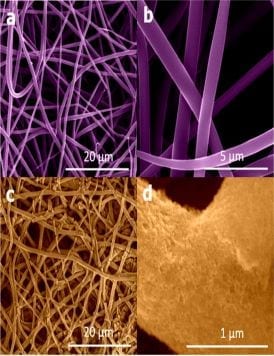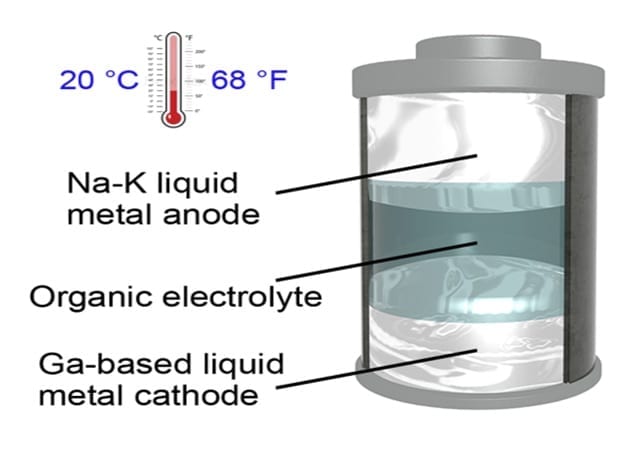
Researchers create silicon nanofibers 100 times thinner than human hair for potential applications in batteries for electric cars and personal electronics
Researchers at the University of California, Riverside’s Bourns College of Engineering have developed a novel paper-like material for lithium-ion batteries. It has the potential to boost by several times the specific energy, or amount of energy that can be delivered per unit weight of the battery.
This paper-like material is composed of sponge-like silicon nanofibers more than 100 times thinner than human hair. It could be used in batteries for electric vehicles and personal electronics.
The findings were just published in a paper, “Towards Scalable Binderless Electrodes: Carbon Coated Silicon Nanofiber Paper via Mg Reduction of Electrospun SiO2 Nanofibers,” in the journal Nature Scientific Reports. The authors were Mihri Ozkan, a professor of electrical and computer engineering, Cengiz S. Ozkan, a professor of mechanical engineering, and six of their graduate students: Zach Favors, Hamed Hosseini Bay, Zafer Mutlu, Kazi Ahmed, Robert Ionescu and Rachel Ye.
The nanofibers were produced using a technique known as electrospinning, whereby 20,000 to 40,000 volts are applied between a rotating drum and a nozzle, which emits a solution composed mainly of tetraethyl orthosilicate (TEOS), a chemical compound frequently used in the semiconductor industry. The nanofibers are then exposed to magnesium vapor to produce the sponge-like silicon fiber structure.
Conventionally produced lithium-ion battery anodes are made using copper foil coated with a mixture of graphite, a conductive additive, and a polymer binder. But, because the performance of graphite has been nearly tapped out, researchers are experimenting with other materials, such as silicon, which has a specific capacity, or electrical charge per unit weight of the battery, nearly 10 times higher than graphite.
The problem with silicon is that is suffers from significant volume expansion, which can quickly degrade the battery. The silicon nanofiber structure created in the Ozkan’s labs circumvents this issue and allows the battery to be cycled hundreds of times without significant degradation.
“Eliminating the need for metal current collectors and inactive polymer binders while switching to an energy dense material such as silicon will significantly boost the range capabilities of electric vehicles,” Favors said.
Read more: New Paper-like Material Could Boost Electric Vehicle Batteries
The Latest on: Silicon nanofibers
[google_news title=”” keyword=”Silicon nanofibers” num_posts=”10″ blurb_length=”0″ show_thumb=”left”]
via Google News
The Latest on: Silicon nanofibers
- Silicon Motion Technology Corporation (SIMO)on April 29, 2024 at 9:00 am
TAIPEI, Taiwan and MILPITAS, Calif., April 25, 2024 (GLOBE NEWSWIRE) -- Silicon Motion Technology Corporation (NasdaqGS: SIMO) (“Silicon Motion” or the “Company”) today announced that ...
- Silicon Valley Newson April 28, 2024 at 3:31 pm
© 2024 American City Business Journals. All rights reserved. Use of and/or registration on any portion of this site constitutes acceptance of our User Agreement ...
- Hidden dangers lurking beneath Silicon Valley's tech revolution reveal insidious national security threaton April 28, 2024 at 4:00 am
The cradle of technological innovation in America, Silicon Valley has remained integral to breaking down barriers through entrepreneurial risk and achievement by visionaries across several decades ...
- Top 5 Best Silicone Food Storage Containers in 2024on April 27, 2024 at 5:00 pm
The use of silicone food storage containers is increasingly popular due to their flexibility, durability, and eco-friendly qualities. Unlike plastic containers, they are made of a BPA-free ...
- Top 6 Best Silicone Based Lubes in 2024on April 27, 2024 at 5:00 pm
For those looking for a long-lasting, velvety touch, silicone-based lubricants are the preferred choice. Unlike water-based variants, these do not evaporate or get absorbed into the skin ...
- In Silicon Valley, You Can Be Worth Billions and It’s Not Enoughon April 22, 2024 at 4:59 pm
Andreas Bechtolsheim, the first investor in Google, has an estimated $16 billion fortune. He recently settled charges that he engaged in insider trading for a profit of $415,726. By David ...
- Apple Silicon: The Complete Guideon April 22, 2024 at 5:03 am
Apple introduced the first Apple silicon Macs back in 2020, marking the start of its transition away from Intel's chips. Apple's custom chips are Arm-based and are similar to the A-series chips ...
- Silicon Slopes CEO worries Utah could turn out like California on housingon April 18, 2024 at 9:58 pm
Despite their nearly identical names, Clint Betts doesn’t want Silicon Slopes to become Silicon Valley in one way: housing costs. “I think that we need to avoid the pitfalls of Silicon Valley ...
- Apple silicon was supposed to save the Mac desktop. Instead, it’s killing iton April 14, 2024 at 5:28 am
With the release of the M3 MacBook Air about a month ago, Apple’s laptop lineup became up-to-date, with each MacBook sporting some version of the M3 chip, the latest in Apple silicon.
- Silicon beyond the valleyon April 9, 2024 at 12:23 pm
Silicon is, after oxygen, the most abundant element of the Earth's crust. But although about 75% of the Earth is made from silica — or silicon dioxide (SiO 2), the main constituent of silicate ...
via Bing News










